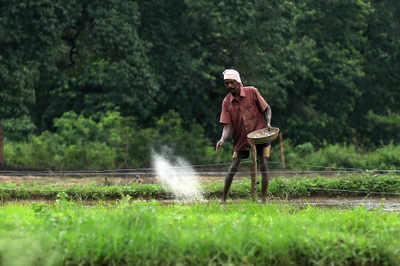- News
- India News
- 90% MPs yet to adopt a village in phase-3 of PM plan
Trending
This story is from November 20, 2017
90% MPs yet to adopt a village in phase-3 of PM plan
Only 68 Lok Sabha MPs chosen villages for Phase-3 of Sansad Adarsh Gram Yojana (SAGY) in 2017 while a paltry 13 Rajya Sabha members out of 245 have named the villages they would want to focus on for development.

NEW DELHI: As many as 475 out of 543 Lok Sabha MPs have not yet identified the village they would adopt for development under Sansad Adarsh Gram Yojana (SAGY), in what indicates a steady decline in interest in the central scheme that was launched by PM Narendra Modi with much fanfare. Only 68 Lok Sabha MPs chosen villages for Phase-3 of SAGY in 2017 while a paltry 13 Rajya Sabha members out of 245 have named the villages they would want to focus on for development.
The numbers are too thin to suggest that the PM's scheme has gained popularity as has been pointed out by government managers over time.
Under SAGY, each MP from the two chambers has to identify a gram panchayat in his constituency to be turned into a model of development. The scheme provides for no separate budget but aims at convergence of ongoing government schemes to improve infrastructure and standard of living in villages. The timeline laid down that Phase-1 would finish by 2016 and two more gram panchayats would be developed by 2019. In what seems an expression of concern, the Union rural development ministry presented the lack of progress in Phase-3 of SAGY at the Performance Review Committee (PRC) meeting last week.
Sources said with personal letters from RD minister Narendra Singh Tomar failing to move MPs, the Centre at the PRC review urged states to ensure that district administrations now meet Parliament members to persuade them to join the scheme.
While as many as 500 LS MPs identified villages in Phase-1, a high number of 203 Rajya Sabha MPs evinced interest too. But since then, the graph has moved south. In Phase-2, 234 LS members and 136 of 243 RS members failed to identify villages. The numbers have dipped alarmingly in Phase-3.
According to officials, the source of indifference towards the scheme has been its design which does not provide for a budget but seeks convergence of existing schemes. Also, parliamentarians, especially those from the lower House, worry that picking one village in the constituency would trigger hostility among other villages, and cost them politically. Insiders said a basic flaw in the scheme was that MPs were being asked to focus on micro-level monitoring work in gram panchayats, which is the domain of MLAs, thereby triggering a conflict between central and state legislators.
The numbers are too thin to suggest that the PM's scheme has gained popularity as has been pointed out by government managers over time.
Under SAGY, each MP from the two chambers has to identify a gram panchayat in his constituency to be turned into a model of development. The scheme provides for no separate budget but aims at convergence of ongoing government schemes to improve infrastructure and standard of living in villages. The timeline laid down that Phase-1 would finish by 2016 and two more gram panchayats would be developed by 2019. In what seems an expression of concern, the Union rural development ministry presented the lack of progress in Phase-3 of SAGY at the Performance Review Committee (PRC) meeting last week.
Sources said with personal letters from RD minister Narendra Singh Tomar failing to move MPs, the Centre at the PRC review urged states to ensure that district administrations now meet Parliament members to persuade them to join the scheme.
Since the PM launched SAGY in 2014, it has been a story of constant dip in interest among MPs.
While as many as 500 LS MPs identified villages in Phase-1, a high number of 203 Rajya Sabha MPs evinced interest too. But since then, the graph has moved south. In Phase-2, 234 LS members and 136 of 243 RS members failed to identify villages. The numbers have dipped alarmingly in Phase-3.
According to officials, the source of indifference towards the scheme has been its design which does not provide for a budget but seeks convergence of existing schemes. Also, parliamentarians, especially those from the lower House, worry that picking one village in the constituency would trigger hostility among other villages, and cost them politically. Insiders said a basic flaw in the scheme was that MPs were being asked to focus on micro-level monitoring work in gram panchayats, which is the domain of MLAs, thereby triggering a conflict between central and state legislators.
End of Article
FOLLOW US ON SOCIAL MEDIA










